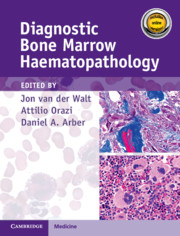Book contents
- Diagnostic Bone Marrow Haematopathology
- Diagnostic Bone Marrow Haematopathology
- Copyright page
- Contents
- Contributors
- Preface
- Acknowledgements
- Chapter 1 The Bone Marrow Biopsy
- Chapter 2 The Normal Bone Marrow
- Chapter 3 Necrosis, Stromal Changes and Artefacts
- Chapter 4 Aplasia
- Chapter 5 Hyperplasia
- Chapter 6 Infective, Granulomatous and Benign Histiocytic Disorders
- Chapter 7 Malignant Disorders of the Histiocytic/Dendritic Lineage
- Chapter 8 Myelodysplastic Syndromes
- Chapter 9 Acute Myeloid Leukaemia
- Chapter 10 Myeloproliferative Neoplasms
- Chapter 11 Myelodysplastic/Myeloproliferative Neoplasms
- Chapter 12 Systemic Mastocytosis
- Chapter 13 Myeloid and Lymphoid Neoplasms Associated with Eosinophilia
- Chapter 14 Precursor Lymphoid Neoplasms
- Chapter 15 Mature Lymphoid Neoplasms
- Chapter 16 Plasma Cell Neoplasia
- Chapter 17 Metastatic Lesions
- Chapter 18 Bone Marrow Changes Following Therapy and Immunosuppression
- Chapter 19 Immunohistochemistry and Flow Cytometry in Bone Marrow Haematopathology
- Chapter 20 Molecular Diagnostics in Bone Marrow Haematopathology
- Index
- References
Chapter 19 - Immunohistochemistry and Flow Cytometry in Bone Marrow Haematopathology
Published online by Cambridge University Press: 12 November 2020
- Diagnostic Bone Marrow Haematopathology
- Diagnostic Bone Marrow Haematopathology
- Copyright page
- Contents
- Contributors
- Preface
- Acknowledgements
- Chapter 1 The Bone Marrow Biopsy
- Chapter 2 The Normal Bone Marrow
- Chapter 3 Necrosis, Stromal Changes and Artefacts
- Chapter 4 Aplasia
- Chapter 5 Hyperplasia
- Chapter 6 Infective, Granulomatous and Benign Histiocytic Disorders
- Chapter 7 Malignant Disorders of the Histiocytic/Dendritic Lineage
- Chapter 8 Myelodysplastic Syndromes
- Chapter 9 Acute Myeloid Leukaemia
- Chapter 10 Myeloproliferative Neoplasms
- Chapter 11 Myelodysplastic/Myeloproliferative Neoplasms
- Chapter 12 Systemic Mastocytosis
- Chapter 13 Myeloid and Lymphoid Neoplasms Associated with Eosinophilia
- Chapter 14 Precursor Lymphoid Neoplasms
- Chapter 15 Mature Lymphoid Neoplasms
- Chapter 16 Plasma Cell Neoplasia
- Chapter 17 Metastatic Lesions
- Chapter 18 Bone Marrow Changes Following Therapy and Immunosuppression
- Chapter 19 Immunohistochemistry and Flow Cytometry in Bone Marrow Haematopathology
- Chapter 20 Molecular Diagnostics in Bone Marrow Haematopathology
- Index
- References
Summary
Immunophenotyping is an important part of the integrated haematopathologic diagnostics of bone marrow (BM) samples. Integrated diagnosis should include clinical information, peripheral blood (PB) and BM smear cytology, flow cytometry (FCM) of BM aspirate, BM trephine biopsy (BMB) morphology, BMB immunohistochemistry (IHC) and cytogenetic/molecular genetic data if appropriate. Flow cytometry and IHC provide complementary information [1]. Immunophenotyping by FCM has the advantage of measuring high numbers of cells and the possibility to evaluate co-expression of several markers in various cell populations in a multicolour setting. Immunohistochemistry provides a possibility of in situ interpretation of morphology and immunophenotype simultaneously. Double IHC stains are possible but not widely used as of yet.
- Type
- Chapter
- Information
- Diagnostic Bone Marrow Haematopathology , pp. 340 - 361Publisher: Cambridge University PressPrint publication year: 2021



